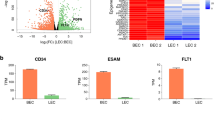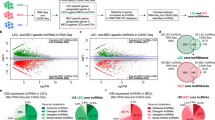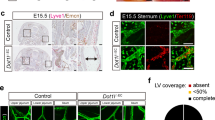Abstract
During embryonic development, the lymphatic system emerges by transdifferentiation from the cardinal vein. Although lymphatic and blood vasculature share a close molecular and developmental relationship, they display distinct features and functions. However, even after terminal differentiation, transitions between blood endothelial cells (BEC) and lymphatic endothelial cells (LEC) have been reported. Since phenotypic plasticity and cellular differentiation processes frequently involve epigenetic mechanisms, we hypothesized that DNA methylation might play a role in regulating cell type-specific expression in endothelial cells. By analyzing global gene expression and methylation patterns of primary human dermal LEC and BEC, we identified a highly significant set of genes, which were differentially methylated and expressed. Pathway analyses of the differentially methylated and upregulated genes in LEC revealed involvement in developmental and transdifferentiation processes. We further identified a set of novel genes, which might be implicated in regulating BEC-LEC plasticity and could serve as therapeutic targets and/or biomarkers in vascular diseases associated with alterations in the endothelial phenotype.




Similar content being viewed by others
References
Tammela T, Alitalo K (2010) Lymphangiogenesis: molecular mechanisms and future promise. Cell 140(4):460–476
Hong YK, Shin JW, Detmar M (2004) Development of the lymphatic vascular system: a mystery unravels. Dev Dyn 231(3):462–473
Karpanen T, Alitalo K (2008) Molecular biology and pathology of lymphangiogenesis. Annu Rev Pathol 3:367–397
Adams RH, Alitalo K (2007) Molecular regulation of angiogenesis and lymphangiogenesis. Nat Rev Mol Cell Biol 8(6):464–478
Risau W (1997) Mechanisms of angiogenesis. Nature 386(6626):671–674
Srinivasan RS et al (2007) Lineage tracing demonstrates the venous origin of the mammalian lymphatic vasculature. Genes Dev 21(19):2422–2432
Oliver G, Harvey N (2002) A stepwise model of the development of lymphatic vasculature. Ann N Y Acad Sci 979:159–165 (discussion 188–196)
Wigle JT, Oliver G (1999) Prox1 function is required for the development of the murine lymphatic system. Cell 98(6):769–778
Breiteneder-Geleff S et al (1999) Angiosarcomas express mixed endothelial phenotypes of blood and lymphatic capillaries: podoplanin as a specific marker for lymphatic endothelium. Am J Pathol 154(2):385–394
Kaipainen A et al (1995) Expression of the fms-like tyrosine kinase 4 gene becomes restricted to lymphatic endothelium during development. Proc Natl Acad Sci USA 92(8):3566–3570
Bixel MG, Adams RH (2008) Master and commander: continued expression of Prox1 prevents the dedifferentiation of lymphatic endothelial cells. Genes Dev 22(23):3232–3235
Cooley LS et al (2010) Reversible transdifferentiation of blood vascular endothelial cells to a lymphatic-like phenotype in vitro. J Cell Sci 123(Pt 21):3808–3816
Groger M et al (2004) IL-3 induces expression of lymphatic markers Prox-1 and podoplanin in human endothelial cells. J Immunol 173(12):7161–7169
Groger M et al (2007) A previously unknown dermal blood vessel phenotype in skin inflammation. J Invest Dermatol 127(12):2893–2900
Tammela T et al (2008) Blocking VEGFR-3 suppresses angiogenic sprouting and vascular network formation. Nature 454(7204):656–660
Feinberg AP (2007) Phenotypic plasticity and the epigenetics of human disease. Nature 447(7143):433–440
Bird A (2007) Perceptions of epigenetics. Nature 447(7143):396–398
Reik W (2007) Stability and flexibility of epigenetic gene regulation in mammalian development. Nature 447(7143):425–432
Suzuki MM, Bird A (2008) DNA methylation landscapes: provocative insights from epigenomics. Nat Rev Genet 9(6):465–476
Laurent L et al (2010) Dynamic changes in the human methylome during differentiation. Genome Res 20(3):320–331
Li E (2002) Chromatin modification and epigenetic reprogramming in mammalian development. Nat Rev Genet 3(9):662–673
Lister R et al (2009) Human DNA methylomes at base resolution show widespread epigenomic differences. Nature 462(7271):315–322
Ribatti D, Nico B, Crivellato E (2009) Morphological and molecular aspects of physiological vascular morphogenesis. Angiogenesis 12(2):101–111
Chan Y et al (2004) The cell-specific expression of endothelial nitric-oxide synthase: a role for DNA methylation. J Biol Chem 279(33):35087–35100
Kim JY et al (2009) The expression of VEGF receptor genes is concurrently influenced by epigenetic gene silencing of the genes and VEGF activation. Epigenetics 4(5):313–321
Matsumura S et al (2007) DNA demethylation of vascular endothelial growth factor-C is associated with gene expression and its possible involvement of lymphangiogenesis in gastric cancer. Int J Cancer 120(8):1689–1695
Schmittgen TD, Livak KJ (2008) Analyzing real-time PCR data by the comparative C(T) method. Nat Protoc 3(6):1101–1108
Sandoval J et al (2011) Validation of a DNA methylation microarray for 450,000 CpG sites in the human genome. Epigenetics 6(6):692–702
Gronniger E et al (2010) Aging and chronic sun exposure cause distinct epigenetic changes in human skin. PLoS Genet 6(5):e1000971
Smyth GK (2004) Linear models and empirical bayes methods for assessing differential expression in microarray experiments. Stat Appl Genet Mol Biol 3:Article3
Benjamini Y, Hochberg Y (1995) Controlling the false discovery rate: a practical and powerful approach to multiple testing. J R Stat Soc Series B 57(1):289–300
Baluk P, McDonald DM (2008) Markers for microscopic imaging of lymphangiogenesis and angiogenesis. Ann N Y Acad Sci 1131:1–12
Kriehuber E et al (2001) Isolation and characterization of dermal lymphatic and blood endothelial cells reveal stable and functionally specialized cell lineages. J Exp Med 194(6):797–808
Sozzani R et al (2010) Spatiotemporal regulation of cell-cycle genes by SHORTROOT links patterning and growth. Nature 466(7302):128–132
Bibikova M, Fan JB (2009) Genome-wide DNA methylation profiling. Wiley Interdiscip Rev Syst Biol Med 2(2):210–223
Yuan L et al (2002) Abnormal lymphatic vessel development in neuropilin 2 mutant mice. Development 129(20):4797–4806
Karpanen T et al (2006) Functional interaction of VEGF-C and VEGF-D with neuropilin receptors. FASEB J 20(9):1462–1472
Ayadi A et al (2001) Net-targeted mutant mice develop a vascular phenotype and up-regulate egr-1. EMBO J 20(18):5139–5152
Nelson GM et al (2007) Differential gene expression of primary cultured lymphatic and blood vascular endothelial cells. Neoplasia 9(12):1038–1045
Petrova TV et al (2002) Lymphatic endothelial reprogramming of vascular endothelial cells by the Prox-1 homeobox transcription factor. EMBO J 21(17):4593–4599
Podgrabinska S et al (2002) Molecular characterization of lymphatic endothelial cells. Proc Natl Acad Sci USA 99(25):16069–16074
Saharinen P et al (2004) Lymphatic vasculature: development, molecular regulation and role in tumor metastasis and inflammation. Trends Immunol 25(7):387–395
Romanowska M et al (2008) PPARdelta enhances keratinocyte proliferation in psoriasis and induces heparin-binding EGF-like growth factor. J Invest Dermatol 128(1):110–124
Madsen P et al (1992) Molecular cloning and expression of a novel keratinocyte protein (psoriasis-associated fatty acid-binding protein [PA-FABP]) that is highly up-regulated in psoriatic skin and that shares similarity to fatty acid-binding proteins. J Invest Dermatol 99(3):299–305
Liu CA et al (2004) Rho/Rhotekin-mediated NF-kappaB activation confers resistance to apoptosis. Oncogene 23(54):8731–8742
Carmeliet P, Jain RK (2000) Angiogenesis in cancer and other diseases. Nature 407(6801):249–257
Carmeliet P (2003) Angiogenesis in health and disease. Nat Med 9(6):653–660
Hong YK et al (2004) Lymphatic reprogramming of blood vascular endothelium by Kaposi sarcoma-associated herpesvirus. Nat Genet 36(7):683–685
Portela A, Esteller M (2010) Epigenetic modifications and human disease. Nat Biotechnol 28(10):1057–1068
Goll MG, Bestor TH (2005) Eukaryotic cytosine methyltransferases. Annu Rev Biochem 74:481–514
Rauch TA et al (2009) A human B cell methylome at 100-base pair resolution. Proc Natl Acad Sci USA 106(3):671–678
Lorincz MC et al (2004) Intragenic DNA methylation alters chromatin structure and elongation efficiency in mammalian cells. Nat Struct Mol Biol 11(11):1068–1075
Zilberman D et al (2007) Genome-wide analysis of Arabidopsis thaliana DNA methylation uncovers an interdependence between methylation and transcription. Nat Genet 39(1):61–69
Klose RJ, Bird AP (2006) Genomic DNA methylation: the mark and its mediators. Trends Biochem Sci 31(2):89–97
Deaton AM, Bird A (2011) CpG islands and the regulation of transcription. Genes Dev 25(10):1010–1022
Eckhardt F et al (2006) DNA methylation profiling of human chromosomes 6, 20 and 22. Nat Genet 38(12):1378–1385
Hellman A, Chess A (2007) Gene body-specific methylation on the active X chromosome. Science 315(5815):1141–1143
Rountree MR, Selker EU (1997) DNA methylation inhibits elongation but not initiation of transcription in Neurospora crassa. Genes Dev 11(18):2383–2395
Barry C, Faugeron G, Rossignol JL (1993) Methylation induced premeiotically in Ascobolus: coextension with DNA repeat lengths and effect on transcript elongation. Proc Natl Acad Sci USA 90(10):4557–4561
Lin CI et al (2008) Lysophosphatidic acid up-regulates vascular endothelial growth factor-C and lymphatic marker expressions in human endothelial cells. Cell Mol Life Sci 65(17):2740–2751
Al-Rawi MA et al (2005) The effects of interleukin-7 on the lymphangiogenic properties of human endothelial cells. Int J Oncol 27(3):721–730
Al-Rawi MA et al (2005) Interleukin 7 upregulates vascular endothelial growth factor D in breast cancer cells and induces lymphangiogenesis in vivo. Br J Surg 92(3):305–310
Valtola R et al (1999) VEGFR-3 and its ligand VEGF-C are associated with angiogenesis in breast cancer. Am J Pathol 154(5):1381–1390
Rocha SF, Adams RH (2009) Molecular differentiation and specialization of vascular beds. Angiogenesis 12(2):139–147
Jing C et al (2001) Human cutaneous fatty acid-binding protein induces metastasis by up-regulating the expression of vascular endothelial growth factor gene in rat Rama 37 model cells. Cancer Res 61(11):4357–4364
Hummerich L et al (2006) Identification of novel tumour-associated genes differentially expressed in the process of squamous cell cancer development. Oncogene 25(1):111–121
Munz M, Zeidler R, Gires O (2005) The tumour-associated antigen EpCAM upregulates the fatty acid binding protein E-FABP. Cancer Lett 225(1):151–157
Adamson J et al (2003) High-level expression of cutaneous fatty acid-binding protein in prostatic carcinomas and its effect on tumorigenicity. Oncogene 22(18):2739–2749
Hirakawa S et al (2003) Identification of vascular lineage-specific genes by transcriptional profiling of isolated blood vascular and lymphatic endothelial cells. Am J Pathol 162(2):575–586
Kunstfeld R et al (2004) Induction of cutaneous delayed-type hypersensitivity reactions in VEGF-A transgenic mice results in chronic skin inflammation associated with persistent lymphatic hyperplasia. Blood 104(4):1048–1057
Acknowledgments
We thank the microarray unit of the DKFZ Genomics and Proteomics Core Facility for providing the Illumina Human Methylation arrays and related services. We thank Frank Lyko (Division of Epigenetics, DKFZ Heidelberg, Germany) for helpful discussions and valuable comments on the manuscript and Sylvain Foret (James Cook University, Townsville) for critical reading of the manuscript.
Conflict of interest
The authors have no conflict of interest.
Author information
Authors and Affiliations
Corresponding author
Additional information
Sabine Hagemann and Marc Winnefeld contributed equally to this work.
Electronic supplementary material
Below is the link to the electronic supplementary material.
10456_2012_9264_MOESM1_ESM.tif
Online Resource 1 Determination of contamination of endothelial cells by other cell types. (a) Fibroblasts could be clearly distinguished from endothelial cells based on their different morphology. (b) FACS diagram showing a contamination of blood endothelial cells with fibroblasts (podoplanin (PDPN) and cluster of differentiation 31 (CD31) negative). (TIFF 1420 kb)
10456_2012_9264_MOESM2_ESM.tif
Online Resource 2 Validation of array-predicted methylation levels in blood and lymphatic endothelial cells. PCR amplification was performed using equimolar sample pools and sequencing results are shown for the arbitrarily chosen genes KN motif and ankyrin repeat domains 3 (KANK3), zinc finger, CCHC domain containing 12 (ZCCHC12), zinc finger, DHHC-type containing 11 (ZDHHC11), and kalirin (KALRN). 454 sequencing coverage ranged from 35 to 389 reads, as indicated. Red boxes indicate methylated, blue boxes unmethylated CpG dinucleotides, and white boxes indicate sequence gaps. CpG loci interrogated by the array are represented by black triangles. The tables below show averaged methylation values (AVB) for respective CpG loci calculated from Illumina array data. LEC, lymphatic endothelial cells; BEC, blood endothelial cells. (TIFF 1267 kb)
10456_2012_9264_MOESM3_ESM.tif
Online Resource 3 Validation of correlation of differentially methylated and expressed genes by 454 bisulfite sequencing and qRT-PCR (a) PCR amplification was carried out using equimolar sample pools of 6 blood (BEC) and 6 lymphatic endothelial cell populations (LEC) and sequencing results are shown for homebox A5 (HOXA5), trefoil factor 3 (TFF3), and XIAP associated factor 1 (XAF1). Sequencing coverage ranged from 106 to 262 reads, as indicated. Red boxes indicate methylated, blue boxes indicate unmethylated CpG dinucleotides, and white boxes represent sequence gaps. The horizontal grey bar illustrates the amplified sequence. CpGs interrogated on the Infinium methylation array are indicated by black triangles. (b) To validate distinct expression levels in LEC and BEC, quantitative RT-PCR analysis of the genes HOXA5, TFF3, and XAF1 was performed. Target gene expression was normalized to expression values of the endogenous control GAPDH. The horizontal black lines denote medians and whiskers the 2.5th and 97.5th percentiles. Significant differences are indicated by asterisks. * = p ≤ 0.05; ** = p ≤ 0.01; *** = p ≤ 0.001 (unpaired t-test). n (LEC) = 10, n (BEC) = 6. (TIFF 889 kb)
10456_2012_9264_MOESM4_ESM.tif
Online Resource 4 List of the 24 genes included in the top network “tissue development, cellular movement, and embryonic development”. Green or blue marks indicate that a least one CpG locus with a methylation change greater than 0.15 and Benjamini Hochberg adj. p.val < 0.01 exists in the defined genomic region. Green/blue color gradients indicate the presence of both hypo- and hypermethylated CpG loci. “Promoter” includes the regions TSS1500, TSS200, 5′UTR, and the first exon of genes. TSS, transcription start site. (TIFF 311 kb)
10456_2012_9264_MOESM5_ESM.tif
Online Resource 5 Pathway Analysis of 375 differentially methylated and expressed genes. Ingenuity Pathway Analysis reveals significantly enriched functional categories for upregulated and downregulated genes in lymphatic (LEC) versus blood endothelial cells (BEC). (TIFF 201 kb)
Rights and permissions
About this article
Cite this article
Brönneke, S., Brückner, B., Peters, N. et al. DNA methylation regulates lineage-specifying genes in primary lymphatic and blood endothelial cells. Angiogenesis 15, 317–329 (2012). https://doi.org/10.1007/s10456-012-9264-2
Received:
Accepted:
Published:
Issue Date:
DOI: https://doi.org/10.1007/s10456-012-9264-2




